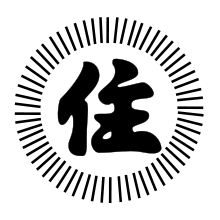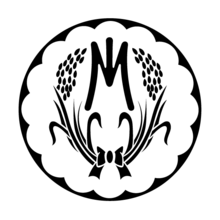List of Yakuza syndicates
Yakuza (Japanese: ヤクザ, [jaꜜkɯza]), also known as gokudō (極道, "the extreme path"), are members of transnational organized crime syndicates originating in Japan. They operate internationally with an estimated 102,000 members.[1]
Syndicates
Four largest syndicates
Although yakuza membership has declined following an anti-gang law aimed specifically at yakuza and passed by the Japanese government in 1992, there are thought to be more than 58,000 active yakuza members in Japan today.[2][3]
| Principal families | Description | Mon (crest) |
|---|---|---|
| Yamaguchi-gumi (六代目山口組 Rokudaime Yamaguchi-gumi) | The Yamaguchi-gumi is the biggest yakuza family, accounting for 50% of all yakuza in Japan, with more than 55,000 members divided into 850 clans. |  "Yamabishi" (山菱) |
| Sumiyoshi-kai (住吉会) | The Sumiyoshi-kai is the second largest yakuza family, with 20,000 members divided into 277 clans. Sumiyoshi-kai is a confederation of smaller yakuza groups. Its current head (会長 oyabun) is Isao Seki. |  |
| Inagawa-kai (稲川会) | The Inagawa-kai is the third largest yakuza family in Japan, with roughly 15,000 members divided into 313 clans. It is based in the Tokyo-Yokohama area and was one of the first yakuza families to expand its operations outside of Japan. |  |
| Aizukotetsu-kai (六代目会津小鉄会 Rokudaime Aizukotetsu-kai) | The Aizukotetsu-kai is the fourth largest yakuza family in Japan, with roughly 7,000 members. Rather than a stand-alone gang, the Aizukotetsu-kai is a federation of approximately 100 of Kyoto's various yakuza groups. Its name comes from the Aizu region, "Kotetsu", a type of Japanese sword. Its main base is in Kyoto. |  |
Designated bōryokudan
A designated boryokudan (指定暴力団 Shitei Bōryokudan)[4] is a "particularly harmful" yakuza group[5] registered by the Prefectural Public Safety Commissions under the Organized Crime Countermeasures Law (暴力団対策法 Bōryokudan Taisaku Hō) enacted in 1991.[6]
The numbers that follow the names of boryokudan groups refer to the group's leadership. For example, Yoshinori Watanabe headed the Yamaguchi-gumi fifth; on his retirement, Shinobu Tsukasa became head of the Yamaguchi-gumi sixth, and "Yamaguchi-gumi VI" is the group's formal name.
| Name | Japanese Name | Headquarters | Reg. in | Notes |
|---|---|---|---|---|
| 六代目山口組 | Kobe, Hyogo | 1992 | Yamaguchi means the surname of the boss and kumi or gumi means group. | |
| 稲川会 | Minato, Tokyo | 1992 | Inagawa means the surname of the boss and kai means organization or society. It is a member of the Kantō-Shinboku-kai (Kanto social gathering). | |
| 住吉会 | Minato, Tokyo | 1992 | Sumiyoshi means the name of place. It is a member of the Kantō-Shinboku-kai. | |
| 六代目会津小鉄会 | Kyoto, Kyoto | 1992 | It was renamed from Aizu-Kotetsu in 1998. Aizu Kotetsu means the nickname of the first boss and Aizu means the name of place. | |
| 五代目工藤會 | Kitakyushu, Fukuoka | 1992 | It was renamed from Kudō-rengō-Kusano-ikka in 1999. Kudō means the surname of the boss. It is a member of the Yonsha-kai (Four social gathering). | |
| 旭琉會 | Okinawa, Okinawa | 1992 | It was renamed from Okinawa-Kyokuryū-kai in 2011. | |
| 五代目共政会 | Hiroshima, Hiroshima | 1992 | It is a member of the Gosha-kai (Five social gathering). | |
| 七代目合田一家 | Shimonoseki, Yamaguchi | 1992 | Gōda means the surname of the boss and ikka means family. It is a member of the Gosha-kai. | |
| 四代目小桜一家 | Kagoshima, Kagoshima | 1992 | ||
| 五代目浅野組 | Kasaoka, Okayama | 1992 | Asano means the surname of the boss. It is a member of the Gosha-kai. | |
| 道仁会 | Kurume, Fukuoka | 1992 | It is a member of the Yonsha-kai. | |
| 二代目親和会 | Takamatsu, Kagawa | 1992 | It is a member of the Gosha-kai. | |
| 双愛会 | Ichihara, Chiba | 1992 | It is a member of the Kantō-Shinboku-kai. | |
| 三代目俠道会 | Onomichi, Hiroshima | 1993 | It is a member of the Gosha-kai. | |
| 太州会 | Tagawa, Fukuoka | 1993 | Taishū means the nickname of the first boss. It is a member of the Yonsha-kai. | |
| 九代目酒梅組 | Osaka, Osaka | 1993 | ||
| 極東会 | Toshima, Tokyo | 1993 | Kyokutō means Far East. It is a member of the Kantō-Shinnō-Doushi-kai (Kanto Shennong Association). It is a tekiya group. | |
| 二代目東組 | Osaka, Osaka | 1993 | Azuma means the surname of the boss. | |
| 松葉会 | Taito, Tokyo | 1994 | Matsuba means pine needle, is kamon of the boss of predecessor syndicate Sekine-gumi. It is a member of the Kantō-Shinboku-kai. | |
| 三代目福博会 | Fukuoka, Fukuoka | 2000 | Fukuhaku means the name of place, Hakata Fukuoka. | |
| Namikawa-kai | 浪川会 | Omuta, Fukuoka | 2008 | It was formed from split from Dojin-kai in 2006 and remained active until on June 11, 2013, when the senior members of the Kyushu Seido-kai said that the gang was disbanding to rejoin the Dojin-kai after resolving the problems the dispute had caused. On October 7, 2013 was formed the Namikawa-mutsumi-kai by upper members of the former Kyushu-Seido-kai when they visited a shrine in Kumamoto Prefecture when one member read aloud an oath announcing the formation of the new yakuza group, based in Omuta City, Fukuoka. Namikawa means the surname of the boss. |
| 神戸山口組 | Awaji, Hyogo | 2016 | It was split of Yamaguchi-gumi VI in 2015. | |
Designated bōryokudan in the past
| Name | Japanese Name | Headquarters | Designated in | Notes |
|---|---|---|---|---|
| Ishikawa-ikka | 石川一家 | Saga | 1993–1995 | Ishikawa means the surname of the boss. It was joined to the Yamaguchi-gumi V in 1995. |
| Dainippon-Heiwa-kai II | 二代目大日本平和会 | Hyogo | 1994–1997 | It was successor of Honda-kai. Dainippon means Great Japan and heiwa means peace. It was not designated update. |
| Kumamoto-rengō Yamano-kai III | 熊本連合 三代目山野会 | Kumamoto | 1998–2001 | Kumamoto means the name of place and rengo means coalition. Yamano means the surname of the boss. It was destroyed. |
| Kyokutō-Sakurai-sōke-rengō-kai | 極東桜井總家連合会 | Shizuoka | 1993–2005 | Sakurai means the surname of the boss, sōke means all family or head family and rengō-kai means federation. It disappeared. |
| Kokusui-kai | 國粹会 | Tokyo | 1994–2005 | Kokusui means Japanese nationalism. It was joined to the Yamaguchi-gumi VI. |
| Nakano-kai | 中野会 | Osaka | 1999–2005 | It was split from Yamaguchi-gumi in 1997. Nakano means the surname of the boss. It was disbanded in 2005. |
| Kyokuryū-kai IV | 四代目旭琉會 | Okinawa | 1992–2012 | It has been merged into Okinawa-Kyokuryū-kai in 2011. |
Other notable bōryokudan
| Name | Japanese name | Headquarters | Boss | Notes |
|---|---|---|---|---|
| Seishin-kai | 清心会 | Iwate | Ōta Seigo? (太田 清吾) | Its core is the Tokyo-Seidai-Hoshi-ikka-Ota III (東京盛代星一家太田三代目). |
| Genseida-Kōyū-kai | 源清田交友会 | Ibaraki | Shiroo Tanabe (田名辺 城男) | Its core is the Genseida-Tanabe III (源清田田名辺三代目). It had once belonged to the Zen-Nihon-Genseida-rengo-kai (全日本源清田連合会). |
| Matsuba-kai-Sekine-gumi | 松葉会関根組 | Ibaraki | Nariaki Ōtsuka (大塚 成晃) | It was split from Matsuba-kai in 2014. Sekine is the surname of the boss. |
| Chōrakuji-ikka III | 三代目長楽寺一家 | Tochigi | Kazuo Hori (堀 和雄) | |
| Yorii-sōke VII | 七代目寄居宗家 | Gunma | Kiyoshi Kawada? (川田 清史) | It withdrew from Kōdō-kai. Yorii is a place name and soke means head family. |
| Yorii-bunke V | 寄居分家五代目 | Gunma | Hiroshi Godai (五代 博) | Bunke means branch family. Member of the Kantō-Shinnō-Doushi-kai. |
| Kameya-ikka V | 五代目亀屋一家 | Saitama | Akira Shirahata? (白畑 晟) | It was split from Takezawa-kai. |
| Yoshiha-kai VII | 七代目吉羽会 | Saitama | Kiyomasa Nakamura (中村 清正) | It was split from Takezawa-kai. Member of the Kanto-Shinno-Doushi-kai. |
| Takezawa-kai | 竹澤会 | Chiba | Haruo Ōtawa (太田和 春雄) | Formerly known as Zen-Takezawa-rengō-kai. Takezawa is the surname of the boss. Member of the Kanto-Shinno-Doushi-kai. |
| Asakusa-Sanzun V | 五代目浅草三寸 | Tokyo | Yutaka Fujisaki (藤咲 豊) | Asakusa is a place name and sanzun is a kind of tekiya. |
| Anegasaki-kai | 姉ヶ崎会 | Tokyo | Shigetami Nakanome (中野目 重民) | Formerly known as Anegasaki-rengō-kai in 2006. Anegasaki is a place name. Member of the Kanto-Shinno-Doushi-kai. |
| Iijima-kai VIII | 八代目飯島会 | Tokyo | Kanji Nishikawa? (西川 冠士) | Formerly known as Zen-Nihon-Iijima-rengō-kai. Iijima is the surname of the boss. Member of the Kanto-Shinno-Doushi-kai. |
| Okaniwa-kai | 岡庭会 | Tokyo | Seiichirō Okaniwa (岡庭 清一郎) | Okaniwa is the surname of the boss. Member of the Kanto-Shinno-Doushi-kai. |
| Kawaguchiya-kai | 川口家会 | Tokyo | Kiyoshi Osaka (大坂 清) | |
| Kanda-Takagi VII | 神田高木七代目 | Tokyo | Akira Nagamura (長村 昭) | Kanda is a place name and Takagi is the surname of the boss. |
| Shitaya-Hanajima-kai? | 下谷花島会 | Tokyo | Ōsaka Isamu]]? (大坂 勇) | Shitaya is a place name. Member of the Kanto-Shinno-Doushi-kai. |
| Jōshūya-kai | 上州家会 | Tokyo | Katsuhiko Itō]] (伊藤 勝彦) | Member of the Kanto-Shinno-Doushi-kai. |
| Shinmon-rengō-kai | 新門連合会 | Tokyo | Naoaki Kasama (笠間 直明) | It has inherited the genealogy of Shinmon Tatsugoro. |
| Sugitō-kai | 杉東会 | Tokyo | Tomoaki Nohara (野原 朝明) | Sugitō means east of Suginami. Formerly known as Sugitō-rengō-kai. Member of the Kanto-Shinno-Doushi-kai. |
| Daigo-kai | 醍醐会 | Tokyo | Hideo Aoyama (青山 秀夫) | Member of the Kanto-Shinno-Doushi-kai. |
| Chōjiya-kai | 丁字家会 | Tokyo | Gorō Yoshida]] (吉田 五郎) | Formerly known as Zen-Chōjiya-rengō-kai. Chōjiya means clove merchants. Member of the Kanto-Shinno-Doushi-kai. |
| Tenjin'yama | 天神山 | Tokyo | unknown | Split from Kyokutō-kai. |
| Tōa-kai | 東亜会 | Tokyo | Yoshio Kaneumi (金海 芳雄) | Successor to Tōsei-kai]]. Tōa means East Asia. Member of the Kanto-Shinboku-kai. |
| Hashiya-kai | 箸家会 | Tokyo | Kōtarō Satō (佐藤 幸太郎) | Member of the Kanto-Shinno-Doushi-kai. |
| Hanamata-kai | 花又会 | Tokyo | Akira Kiyono (清野 昭) | Formerly known as Hanamata-rengō-kai. Member of the Kanto-Shinno-Doushi-kai. |
| Masuya-kai | 桝屋会 | Tokyo | Sotojirō Higashiura (東浦 外次郎) | Formerly known as Zen-Masuya-rengō-kai. Member of the Kanto-Shinno-Doushi-kai. |
| Matsuzakaya-ikka V | 五代目松坂屋一家 | Tokyo | Takichi Nishimura (西村 太吉) | |
| Ryōgokuya-kai | 両国家会 | Tokyo | unknown | Formerly known as Zen-Ryōgokuya-rengō-kai. Member of the Kanto-Shinno-Doushi-kai. |
| Ametoku-rengō-kai | 飴德連合会 | Kanagawa | Hideya Nagamochi? (永持 英哉) | Ametoku is the nickname of the first boss. Member of the Kanto-Shinno-Doushi-kai. |
| Tokuriki-ikka V | 五代目徳力一家 | Kanagawa | unknown | Member of the Kanto-Shinno-Doushi-kai. |
| Yokohama-Kaneko-kai | 横浜金子会 | Kanagawa | Takashi Terada (寺田 隆) | Yokohama is a place name and Kaneko is the surname of the boss. Member of the Kanto-Shinno-Doushi-kai. |
| Sakurai-sōke | 櫻井總家 | Shizuoka | Hiroyoshi Sano (佐野 宏好) | It is successor of Kyutō-Sakurai-sōke-rengō-kai. |
| Chūkyō-Shinnō-kai | 中京神農会 | Aichi | Eizō Yamagashira? (山頭 栄三) | It was split from Dōyū-kai. Chūkyō is a place name and Shinno is Shennong, a mythical sage ruler of prehistoric China. |
| Marutomi-rengō-kai | 丸富連合会 | Kyoto | Satoshi Kitahashi? (北橋 斉) | |
| Sanshaku-gumi-honke IV | 大阪四代目三尺組本家 | Osaka | Aizō Tanaka (田中 愛造) | |
| Naoshima-Giyū-kai | 直嶋義友会 | Osaka | Tadashi Noda (野田 忠志) | Naoshima is the surname of the boss. |
| Kōbe-Hakurō-kai-sōhonbu V | 五代目神戸博労会総本部 | Hyogo | Shikano Noboru? (鹿野 昇) | Kōbe and Hakurō is a place name. |
| Chūsei-kai | 忠成会 | Hyogo | Tadaaki Ōmori (大森 匡晃) | |
| Matsuura-gumi II | 二代目松浦組 | Hyogo | Kazuo Kasaoka (笠岡 一雄) | Matsuura is the surname of the boss. |
| Konjin-Tsumura-sōhonke II | 二代目金神津村總本家 | Hiroshima | Yoshisuke Tsumura? (津村 義輔) | Sōhonke means all family or head family. |
| Chūgoku-Takagi-kai III | 三代目中国高木会 | Hiroshima | Hideyoshi Daigen? (大源 秀吉) | Successor to Kyōsei-kai Murakami-gumi. Chūgoku is a place name and Takagi is the surname of the boss. |
| Kyūshū-Kashida-kai III | 三代目九州樫田会 | Fukuoka | Takashi Koga? (古賀 孝司) | Kyūshū is a place name and Kashida is the surname of the boss. |
| Tatekawa-kai? III | 九州三代目立川会 | Fukuoka | Toshihiko Ikeura (池浦 敏彦) | |
| Nakanishi-kai | 中西会 | Fukuoka | unknown | |
| Fujiie-kai? | 藤家会 | Fukuoka | Mitsuo Nakao (中尾 光男) | Fujiie is the surname of the boss. |
| Kyūshū-Kumashiro-rengō ? | 九州神代連合 | Saga | Katsuji Noguchi (野口 勝次) | |
| Kyūshū-Ozaki-kai II | 二代目九州尾崎会 | Nagasaki | Kuniyuki Koga (古賀 國行) | Ozaki is the surname of the boss. |
| Kumamoto-kai III | 三代目熊本會 | Kumamoto | Hidenori Morihara (森原 秀徳) | Successor to Kumamoto-rengō. Member of the Yonsha-kai. |
| Sanshin-kai | 山心会 | Kumamoto | Atsushi Inoue (井上 厚) | Successor to Kumamoto-rengō Yamano-kai. Formerly known as Sanshin-kai (山心会). |
| Murakami-gumi III | 九州三代目村上組 | Oita | Yoshishige Matsuoka (松岡 良茂) | Murakami is the surname of the boss. |
| Nishida-kai V | 五代目西田会 | Miyazaki | Kazuo Tanaka (田中 一夫) |
Other prominent boryokudan
| Name | Japanese name | Headquarters | Notes |
|---|---|---|---|
| Marumo-ikka | 丸茂一家 | Hokkaido | |
| Seiyū-kai | 誠友会 | Hokkaido | Merged with the Yamaguchi-gumi IV in 1985. |
| Zen-Chojiya-Hachiya-rengo-kai | 全丁字家蜂谷連合会 | Hokkaido | Disbanded in 1988, the remaining organizations have subscribed to Kenryu-kai and Kodo-kai. |
| Yorii-Sekiho-rengo | 寄居関保連合 | Hokkaido | Merged with the Yamaguchi-gumi. |
| Umeya-Abe-rengo-kai | 梅家阿部連合会 | Hokkaido | Merged with the Kodo-kai. |
| Kigure-ikka | 木暮一家 | Hokkaido | Merged with the Inagawa-kai. |
| Aizuya-ikka-Kodaka | 会津家一家小高 | Hokkaido | |
| Koshijiya-rengo | 越路家連合 | Hokkaido | Merged with the Inagawa-kai. |
| Kanto-Komatsuya-ikka | 関東小松家一家 | Hokkaido | |
| Oshu-Umeya-rengo-kai | 奥州梅家連合会 | Aomori | Merged with the Inagawa-kai. |
| Oshu-Saikaiya-so-rengo-kai | 奥州西海家総連合会 | Miyagi | Merged with the Sumiyoshi-kai. |
| Tokyo-Seidai-Nishikido-kai | 東京盛代錦戸会 | Miyagi | Merged with the Sumiyoshi-kai. |
| Tokyo-Seidai-Kawasaki-kai | 東京盛代川崎会 | Miyagi | Merged with the Sumiyoshi-kai. |
| Nishikata-ikka | 西方一家 | Miyagi | |
| Anegasaki-Yagami-kai | 姉ケ崎八神会 | Akita | Merged with the Inagawa-kai. |
| Aizuya-ikka-Nomoto | 会津家一家野本 | Akita | Merged with the Kyokuto-kai. |
| Oshu-Yamaguchi-rengo | 奥州山口連合 | Yamagata | Merged with the Sumiyoshi-kai. |
| Oshu-Aizu-Kakusada-ikka | 奥州会津角定一家 | Fukushima | Merged with the Yamaguchi-gumi. |
| Maruto-kai | 丸唐会 | Fukushima | Merged with the Sumiyoshi-kai. |
| Matsuba-kai-Doushi-kai | 松葉会同志会 | Ibaraki | Disbanded, then joined to the Matsuba-kai. |
| Shinwa-kai | 親和会 | Tochigi | Merged with the Sumiyoshi-kai. |
| Kochiya-kai | 河内家会 | Tochigi | Merged with the Kyokuto-kai. |
| Zennihon-Yorii-rengo-kai | 全日本寄居連合会 | Gunma | Disappeared. |
| Kanto-Kumaya-rengo | 関東熊屋連合 | Saitama | Merged with Kyokuto-kai. |
| Zennihon-Genseida-rengo-kai | 全日本源清田連合会 | Chiba | Disappeared. |
| Kanto-Chojamachi-kai | 関東長者町会 | Chiba | Merged with Sumiyoshi-kai. |
| Minato-kai | 港会 | Tokyo | Disbanded, then taken over by Sumiyoshi-kai. |
| Kohei-ikka | 幸平一家 | Tokyo | Merged with the Minato-kai. |
| Doshida-ikka | 圡支田一家 | Tokyo | |
| Sekine-gumi | 関根組 | Tokyo | Disbanded, then taken over by Matsuba-kai. |
| Ando-gumi (Azuma-kogyo) | 安東組 (東興業) | Tokyo | Disbanded. |
| Tosei-kai | 東声会 | Tokyo | Merged with the Yamaguchi-gumi, then disbanded and taken over by Toa-kai. |
| Koganei-ikka | 小金井一家 | Tokyo | Merged with the Nibiki-kai. |
| Nibiki-kai | 二率会 | Tokyo | Disbanded. |
| Hokusei-kai | 北星会 | Tokyo | Disbanded. |
| Kowa-kai | 交和会 | Tokyo | Successor to the Hokusei-kai. Merged with the Inagawa-kai. |
| Namai-ikka | 生井一家 | Tokyo | Merged with the Kokusui-kai. |
| Ochiai-ikka | 落合一家 | Tokyo | Merged with the Kokusui-kai. |
| Aizuya-rengo-kai | 會津家連合会 | Tokyo | Merged with the Goto-gumi. |
| Tokyo-Yasuda-kai | 東京安田会 | Tokyo | Merged with the Rachi-gumi. |
| Kanto-Hayashi-gumi-rengo-kai | 関東林組連合会 | Tokyo | |
| Kyokuto-Aio-rengo-kai | 極東愛桜連合会 | Tokyo | Disbanded in 1967. |
| Ishimoto-kai | 石元会 | Tokyo | |
| Ryogoku-kai | 両国会 | Tokyo | |
| Kinsei-kai | 錦政会 | Tokyo | |
| Joman-ikka | 上萬一家 | Tokyo | |
| Gijin-to | 義人党 | Kawasaki, Kanagawa | Disbanded. The successor organization has joined the Sumiyoshi-kai. |
| Kanto-Hayashi-gumi-rengo-kai | 関東林組連合会 | ||
| Yokohama-Saikaiya | 横浜西海家 | Kanagawa | Merged with the Kyokuto-kai. |
| Kawauchi-gumi | 川内組 | Fukui | Merged with the Sugatani-gumi. |
| Yamanashi-Kyōyū-kai | 山梨侠友會 | Yamanashi | Split from Inagawa-kai in 2011. "Yamanashi" refers the name of place. Disbanded in 2016, joined Inagawa-kai and renamed Sano-gumi. |
| Shinshu-Saito-ikka | 信州斎藤一家 | Nagano | |
| Yoshihama-kai | 芳浜会 | Gifu | |
| Ikeda-ikka | 池田一家 | Gifu | |
| Shimizu-ikka | 清水一家 | Shizuoka | Merged with the Yamaguchi-gumi. |
| 中泉一家 | Shizuoka | ||
| Reiganjima-Masuya-Hattori-kai | 霊岸島桝屋服部会 | Shizuoka | |
| Honganji-ikka | 本願寺一家 | Aichi | |
| Inabaji-ikka | 稲葉地一家 | Nagoya, Aichi | Merged with the Kodo-kai. |
| Unmeikyodo-kai | 運命共同会 | Aichi | Disbanded. |
| Hirai-ikka | 平井一家 | Toyohashi, Aichi | Merged with the Unmeikyodo-kai. |
| Tesshin-kai | 鉄心会 | Nagoya, Aichi | Merged with the Unmeikyodo-kai. |
| Chukyo-Asano-kai | 中京浅野会 | Aichi | Merged with the Unmeikyodo-kai. |
| Seto-ikka | 瀬戸一家 | Seto, Aichi | Merged with the Yamaguchi-gumi. |
| Doyu-kai | 導友会 | Nagoya, Aichi | Merged with the Kodo-kai. |
| Sankichi-ikka | 三吉一家 | Aichi | |
| Kira-ikka | 吉良一家 | Aichi | |
| Kusuriya-rengo-kai | 薬屋連合会 | Aichi | |
| Kumaya-ikka | 熊屋一家 | Aichi | |
| Nagoya-Chojamachi-ikka | 名古屋長者町一家 | Aichi | |
| Hiranoya-ikka | 平野家一家 | Nagoya, Aichi | Merged with the Kodo-kai. |
| Aio-kai | 愛桜会 | Mie | Merged with the Yamaguchi-gumi. |
| Kanbeya-ikka | 神戸屋一家 | Mie | |
| Shujiro-ikka | 周次郎一家 | ||
| Kamijo-gumi | 上條組 | Mie | |
| Ise-Kanbe-ikka | 伊勢神戸一家 | Mie | |
| Ise-Kawashima-ikka | 伊勢川島一家 | Mie | |
| Tsunan-ikka | 津南一家 | Mie | |
| Mizutani-ikka | 水谷一家 | Mie | Merged with the Yamaguchi-gumi. |
| Ise-Kamiya-ikka | 伊勢紙谷一家 | Mie | |
| Nakajima-rengo-kai | 中島連合会 | Kyoto | Merged with the Aizu-Kotetsu-kai. |
| Sunakogawa-gumi | 砂子川組 | Osaka | Descended of Aizu Kotetsu. |
| Nakamasa-gumi | 中政組 | Osaka | Descended from of Aizu Kotetsu. |
| 小久一家 | Osaka | ||
| 長政 | Osaka | ||
| Dankuma-kai | 淡熊会 | Osaka, Osaka | |
| Yamato-Nara-gumi | 倭奈良組 | Osaka | |
| Dajokan | 大政官 | Osaka | |
| I-rengo | い聯合 | Osaka | |
| Yamaguchi-gumi Yanagawa-gumi | 山口組 柳川組 | Osaka | |
| Hayano-kai | 早野会 | Osaka | |
| Oguruma-Makoto-kai | 小車誠会 | Osaka | |
| Imanishi-gumi | 今西組 | Osaka | Merged with the Sakaume-gumi. |
| Ono-ikka | 大野一家 | Osaka | |
| Minami-ikka | 南一家 | Osaka | |
| Sumida-kai | 澄田会 | Osaka | |
| Matsuda-gumi (Matsuda-rengo) | 松田組 (松田連合) | Osaka | |
| Hadani-gumi | 波谷組 | Osaka | Disbanded in 1994. |
| Komasa-gumi | 小政組 | Osaka | |
| Doi-gumi | 土井組 | Osaka | |
| 九紋龍組 | Osaka | ||
| Oshima-gumi | 大嶋組 | Hyogo | |
| Honda-kai | 本多会 | Hyogo | |
| Ichiwa-kai | 一和会 | Hyogo | Disbanded. |
| Suwa-ikka | 諏訪一家 | Hyogo | |
| Sasaki-gumi | 佐々木組 | Wakayama | |
| Takenaka-gumi | 竹中組 | Okayama | Withdrew from the Yamaguchi-gumi. |
| Kinoshita-kai | 木下会 | Okayama | |
| Takahashi-gumi | 高橋組 | Onomichi, Hiroshima | |
| Katsuura-kai | 勝浦会 | Tokushima | Disbanded in 1998. |
| Mori-kai | 森会 | Tokushima | |
| Matsuyama-rengo-kai | 松山連合会 | Ehime | Merged with the Yamaguchi-gumi. |
| Kyushu-Kyoyu-rengo-kai | 九州侠友連合会 | Fukuoka | |
| Seibu-rengo | 西武連合 | Karatsu, Saga | |
| Kumamoto-rengo | 熊本連合 | Kumamoto | |
| Kitaoka-kai | 北岡会 | Kumamoto | |
| Daimon-kai | 大門会 | Kumamoto |
References
- ↑ Corkill, Edan, "Ex-Tokyo cop speaks out on a life fighting gangs — and what you can do", Japan Times, 6 November 2011, p. 7.
- ↑ "Membership of Japan's yakuza crime gangs falls to all-time low | World news". The Guardian. Retrieved 2018-01-06.
- ↑ Johnston, Eric, "From rackets to real estate, yakuza multifaceted", Japan Times, 14 February 2007, p. 3.
- ↑ "Police of Japan 2011, Criminal Investigation : 2. Fight Against Organized Crime", December 2009, National Police Agency
- ↑ "The Organized Crime Countermeasures Law" Archived 19 January 2012 at the Wayback Machine., The Fukuoka Prefectural Center for the Elimination of Boryokudan (in Japanese)
- ↑ "Boryokudan Comprehensive Measures — The Condition of the Boryokudan", December 2010, Hokkaido Prefectural Police (in Japanese)
Bibliography
- Bruno, A. (2007). "The Yakuza, the Japanese Mafia" CrimeLibrary: Time Warner
- Kaplan, David, Dubro Alec. (1986). Yakuza Addison-Wesley ( ISBN 0-201-11151-9)
- Kaplan, David, Dubro Alec. (2003). Yakuza: Expanded Edition University of California Press ( ISBN 0-520-21562-1)
- Hill, Peter B.E. (2003). The Japanese Mafia: Yakuza, Law, and the State Oxford University Press ( ISBN 0-19-925752-3)
- Johnson, David T. (2001). The Japanese Way of Justice: Prosecuting Crime in Japan Oxford University Press ( ISBN 0-19-511986-X)
- Miyazaki, Manabu. (2005) Toppamono: Outlaw. Radical. Suspect. My Life in Japan's Underworld Kotan Publishing ( ISBN 0-9701716-2-5)
- Seymour, Christopher. (1996). Yakuza Diary Atlantic Monthly Press ( ISBN 0-87113-604-X)
- Saga, Junichi., Bester, John. (1991) Confessions of a Yakuza: A Life in Japan's Underworld Kodansha America
- Schilling, Mark. (2003). The Yakuza Movie Book Stone Bridge Press ( ISBN 1-880656-76-0)
- Sterling, Claire. (1994). Thieves' World Simon & Schuster ( ISBN 0-671-74997-8)
- Sho Fumimura (Writer), Ryoichi Ikegami (Artist). (Series 1993–1997) "Sanctuary" Viz Communications Inc (Vol 1: ISBN 0-929279-97-2; Vol 2: ISBN 0-929279-99-9; Vol 3: ISBN 1-56931-042-4; Vol 4: ISBN 1-56931-039-4; Vol 5: ISBN 1-56931-112-9; Vol 6: ISBN 1-56931-199-4; Vol 7: ISBN 1-56931-184-6; Vol 8: ISBN 1-56931-207-9; Vol 9: ISBN 1-56931-235-4)
- Tendo, Shoko (2007). Yakuza Moon: Memoirs of a Gangster's Daughter Kodansha International ( ISBN 978-4-7700-3042-9)
- Young Yakuza. Dir. Jean-Pierre Limosin. Cinema Epoch, 2007.
External links
| Wikimedia Commons has media related to Yakuza. |
- 101 East – Battling the Yakuza—Al Jazeera (Video)
- "Organized Crime — FBI". fbi.gov. Retrieved 2018-01-06.
- Yakuza Portal site
- Blood ties: Yakuza daughter lifts lid on hidden hell of gangsters' families
- Crime Library: Yakuza
- Yakuza distribution map
- Japanese Mayor Shot Dead; CBS News, 17 April 2007
- Yakuza: The Japanese Mafia
- Yakuza distribution map
- Yakuza: Kind-hearted criminals or monsters in suits?